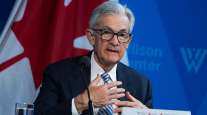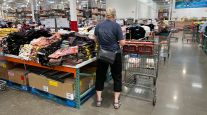US Inflation Quickens to 9.1%, Amping Up Fed Pressure to Go Big

[Stay on top of transportation news: Get TTNews in your inbox.]
U.S. inflation accelerated in June by more than forecast, underscoring relentless price pressures that will keep the Federal Reserve on track for another big interest-rate hike later in July.
The consumer price index rose 9.1% from a year earlier in a broad-based advance, the largest gain since the end of 1981, Labor Department data showed July 13. The widely followed inflation gauge increased 1.3% from a month earlier, the most since 2005, reflecting higher gasoline, shelter and food costs.
Economists projected a 1.1% rise from May and an 8.8% year-over-year increase, based on the Bloomberg survey medians. This was the fourth-straight month that the headline annual figure topped estimates.
President Biden called inflation “unacceptably high” in a statement but said that “today’s data does not reflect the full impact of nearly 30 days of decreases in gas prices that have reduced the price at the pump by about 40 cents since mid-June.”
“Those savings are providing important breathing room for American families,” Biden said in the statement, issued about one hour after the Labor Department’s report.
The so-called core CPI, which strips out the more volatile food and energy components, advanced 0.7% from the prior month and 5.9% from a year ago, above forecasts.
Treasury yields and the dollar jumped, while U.S. stock futures fell following the report.
The red-hot inflation figures reaffirm that price pressures are rampant and widespread throughout the economy and continue to sap purchasing power and confidence. That will keep Fed officials on an aggressive policy course to rein in demand, and adds pressure to President Joe Biden and congressional Democrats whose support has slumped ahead of midterm elections.
While many economists have suggested this data will be the peak in the current inflationary cycle, several factors such as housing stand to keep price pressures elevated for longer. Geopolitical risks including COVID lockdowns in China and Russia’s war in Ukraine also pose risks to supply chains and the inflation outlook.
Fed policymakers have already signaled a second 75 basis-point hike in interest rates later in July amid persistent inflation as well as still-robust job and wage growth. Even before the data was released, traders had already fully priced in a three-quarter percentage-point hike for July.
Now, odds imply a hike of at least 75 basis points is seen as definite and around a one-in-three chance that it could be a full percentage point.
Prices for household necessities continued to post outsized increases in June. Gas prices rose 11.2% in June from a month earlier. Prices for energy services, which includes electricity and natural gas, increased 3.5%, the most since 2006. Food costs, meanwhile, climbed 1% and 10.4% from a year ago, the largest increase since 1981.
Want more news? Listen to today's daily briefing above or go here for more info
Early earnings results from PepsiCo Inc. show some companies are still successfully passing through recent price surges in commodities. The maker of Fritos and Mountain Dew was able to charge customers about 12% more on average in the second quarter. Even so, the company said volumes have held up well.
Rents, Shelter
Rent of primary residence rose 0.8% from May, the largest monthly advance since 1986. Shelter costs overall — which are the biggest services component and make up a third of the overall CPI index — climbed 0.6%, matching the prior month.
While home sales have slowed in recent months due to higher mortgage rates, economists expect rental inflation to continue to increase because it takes time for price changes to feed into the CPI.
The cost of hotel and airline fares, as well as car rentals, fell from May to June, following historic increases in recent months. Even so, recent commentary from U.S. airlines have indicated that travel demand remains strong.
Used car prices, which were a major contributor to inflation last year, rose 1.6% from a month ago, while new vehicle prices increased 0.7%.
Higher prices continue to eat away at consumer incomes, despite strong nominal wage gains. Inflation-adjusted average hourly earnings dropped 3.6% in June from a year earlier, the 15th straight decline and largest in data back to 2007, separate data showed July 13. That’s started to impact spending — inflation-adjusted consumer expenditures fell 0.4% in May, the first decline this year.
With assistance from Chris Middleton and Sydney Maki.




